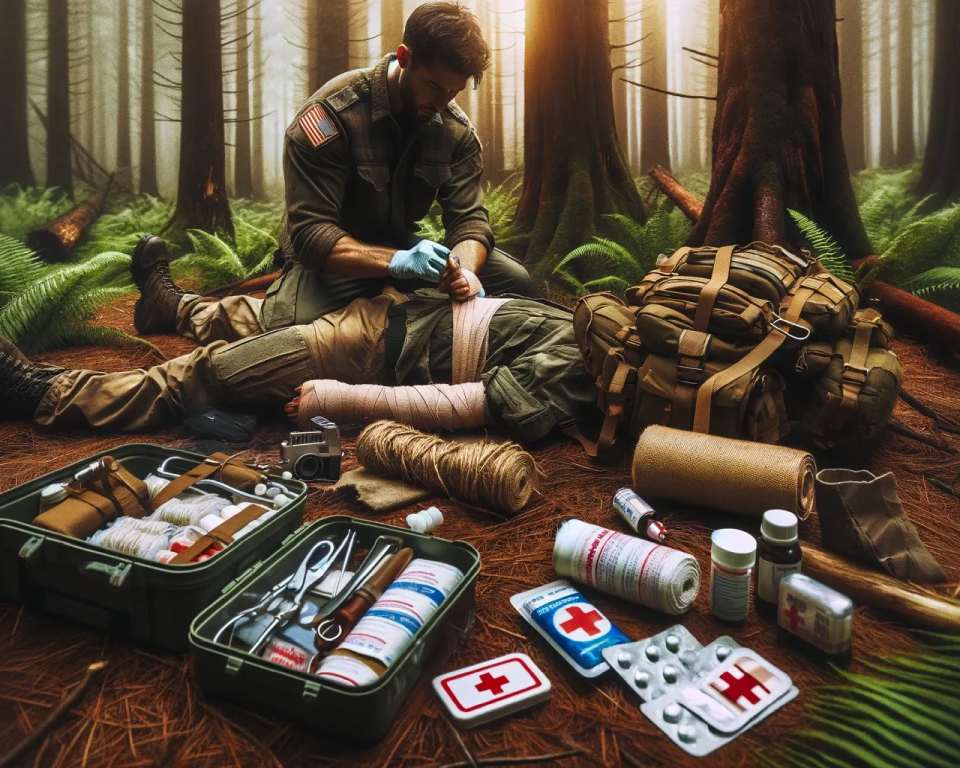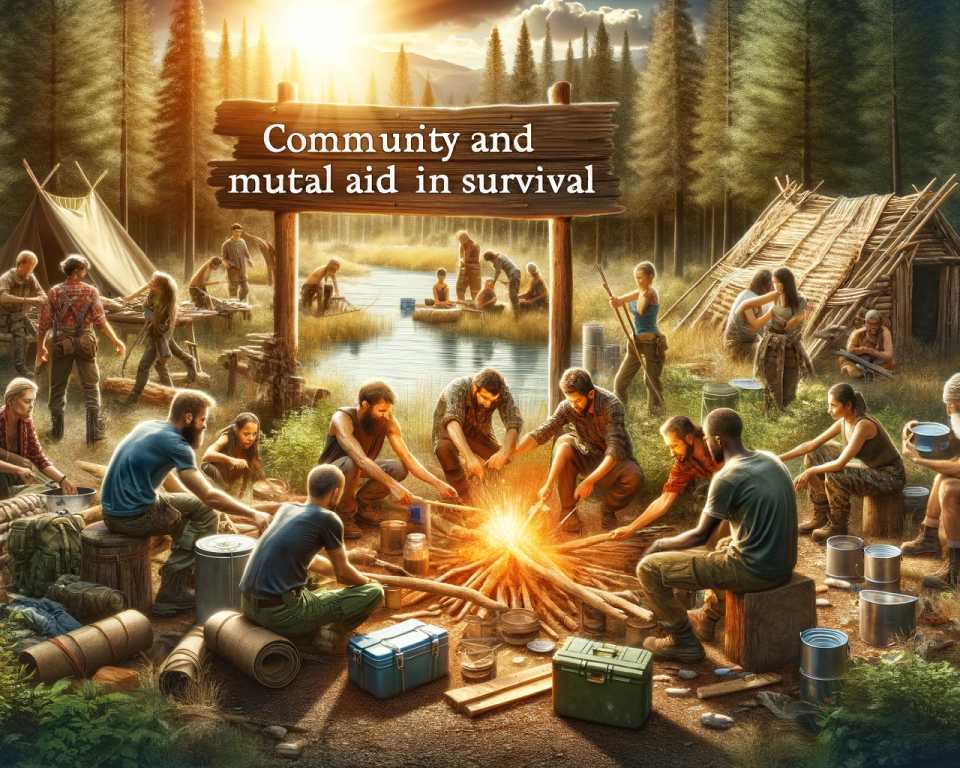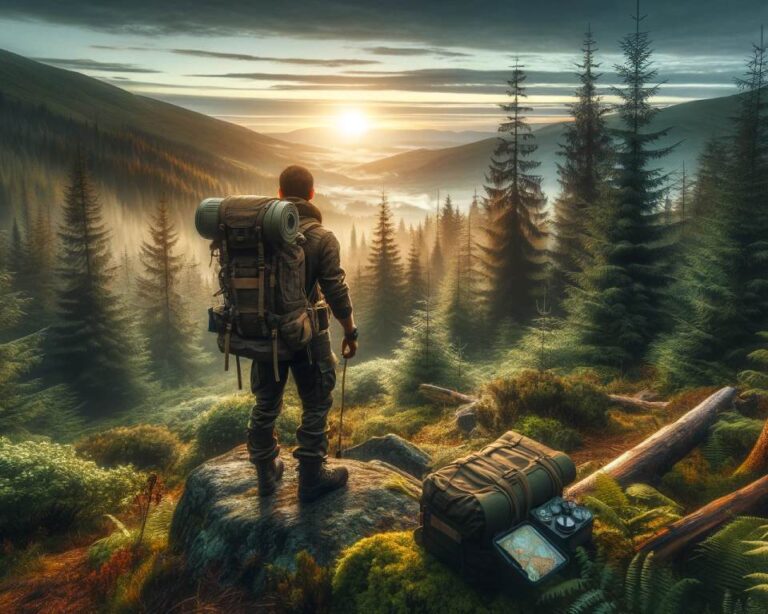Mastering Wilderness Survival: A Comprehensive Guide
Welcome to “Survival for Adults,” your ultimate resource for mastering wilderness survival, developing essential outdoor survival skills, and ensuring emergency preparedness. Whether you’re an avid hiker, a seasoned adventurer, or simply someone who wants to be ready for life’s unexpected challenges, our comprehensive guide is designed to equip you with the knowledge and skills needed to navigate any wilderness scenario with confidence.
In this guide, we will delve into the intricacies of survival psychology, offering insights into the psychological and physiological aspects that define our ability to overcome adversity. From shelter-building and water sourcing to fire-making techniques and more, we’ll cover a wide range of practical skills that are crucial for wilderness survival.
But our guide doesn’t stop there. We’ll also explore essential topics such as wilderness nutrition, navigation and orientation, first aid and medical survival, and even surviving extreme environments. Whether you find yourself lost in the wilderness, facing a natural disaster, or navigating the challenges of an urban crisis, we’ll provide you with the guidance and knowledge to thrive in any situation.
At “Survival for Adults,” we believe that a survival mindset goes beyond mere survival; it embraces the power of adaptability, resilience, and community. That’s why we’ve dedicated sections of our guide to cultivating a survival mindset and understanding the strength in community and mutual aid. Together, we can overcome any obstacle that comes our way.
Join us as we embark on this transformative journey. Together, let’s master wilderness survival, develop outdoor survival skills, and be prepared for any emergency that comes our way. The adventure begins now.
Understanding Survival Principles
Survival is not only about physical strength and practical skills; it is also deeply rooted in the psychology of survival. In this section, we will explore the core principles that underpin our ability to overcome adversity and thrive in unpredictable situations.
The psychology of survival plays a crucial role in determining our response to challenging circumstances. It is our mental resilience, adaptability, and determination that enable us to persevere when faced with life-threatening situations. By understanding the psychological and physiological aspects of survival, we can harness the power of our minds to increase our chances of survival.
“Survival is all about mindset. It is the unwavering belief in our ability to overcome any obstacle that fuels our resilience and drives us forward.”
When faced with a survival situation, our minds can either be our greatest asset or our biggest liability. Developing a survival mindset involves cultivating a positive outlook, managing fear and anxiety, and staying focused on the task at hand. It is this mental fortitude that empowers us to make rational decisions, adapt to changing circumstances, and find innovative solutions to the challenges we encounter.
Moreover, understanding the psychology of survival also involves recognizing the importance of emotional intelligence and interpersonal skills. In a survival scenario, effective communication, teamwork, and cooperation with others can significantly enhance our chances of survival. Building and maintaining strong bonds with fellow survivors can provide emotional support, shared knowledge, and resources when they are needed the most.

The Power of Positive Thinking
One of the key principles of survival psychology is the power of positive thinking. Maintaining a positive mindset can help us overcome fear, despair, and hopelessness. By focusing on solutions rather than dwelling on problems, we can increase our resourcefulness and resilience.
Survival principles extend beyond physical skills and encompass the psychological aspects that make all the difference in challenging situations. By understanding these principles and developing a survival mindset, we can empower ourselves to face any adversity that may come our way.
- Develop mental resilience and adaptability
- Manage fear and anxiety
- Cultivate positive thinking
- Build strong relationships and foster teamwork
- Stay focused and make rational decisions
Essential Survival Skills
When it comes to wilderness survival, mastering essential skills is crucial for your safety and well-being. Building shelter, sourcing clean water, and mastering fire-making techniques are fundamental abilities that will enable you to thrive in the wild. Let’s explore these essential survival skills in detail:
Shelter Building
Building a shelter is essential for protecting yourself from the elements and ensuring a secure resting place. Whether it’s constructing a primitive lean-to, a debris hut, or improvising with natural resources, understanding different shelter-building techniques is key. Learn how to assess your surroundings, identify suitable materials, and construct a sturdy shelter to shield you from harsh weather conditions and potential dangers.
Fire-Making Techniques
Fire is not only a source of warmth but also an invaluable tool for cooking, purifying water, signaling for help, and warding off wildlife. Mastering fire-making techniques empowers you to start a fire using various methods, such as friction-based methods like the bow drill or hand drill, as well as modern tools like fire starters and lighters. Explore different fire-making approaches, practice fire safety, and develop the confidence to ignite a life-sustaining flame in any situation.
Sourcing Clean Water
Access to clean drinking water is vital for survival. In the wild, water sources may be scarce, contaminated, or undrinkable. Learning how to locate, collect, and purify water is essential knowledge. Understand various techniques for sourcing water, such as finding natural springs, building water filters, and purifying methods like boiling, chemical treatments, or using portable water filters. With these skills, you can ensure your hydration needs are met and minimize the risk of waterborne illnesses.
By equipping yourself with these essential survival skills—shelter building, fire-making techniques, and sourcing clean water—you establish a foundation for self-sufficiency and resilience. Remember, preparedness is key to navigating the unpredictability of the wilderness.
Stay tuned for the next section where we delve into the fascinating world of wilderness nutrition and food procurement in the wild.

Food Procurement in the Wild
Navigate the complex world of wilderness nutrition and ensure your long-term survival. In this section, we will explore various methods of procuring food in the wild, including identifying edible plants, trapping small game, and foraging for sustenance.
Identifying Edible Plants
One of the key skills for wilderness nutrition is the ability to identify edible plants. Knowing which plants are safe to consume can greatly expand your food options in the wild. However, it is crucial to exercise caution and thorough knowledge when foraging for edible plants. Incorrect identification can have severe consequences.
Remember, not all plants are safe to eat. Take the time to educate yourself and learn about the edible plants found in your local wilderness. A reputable field guide or a knowledgeable instructor can be invaluable resources in this endeavor.
Trapping Small Game
In addition to plants, trapping small game can provide a valuable source of protein in the wild. Learning basic trapping techniques allows you to catch animals such as squirrels, rabbits, and birds. Constructing effective traps requires patience, knowledge of animal behavior, and the proper tools.
- Research and practice different types of traps, such as snares, deadfalls, and primitive traps.
- Identify suitable locations for setting traps based on animal tracks, droppings, and habitat.
- Ensure you follow local laws and regulations regarding trapping.
Foraging for Sustenance
Foraging involves gathering wild food sources that do not require hunting or trapping. By understanding the edible plants in your surroundings, you can sustain yourself with a variety of nutritious foods.
- Learn about common edible plants in your area and their seasonal availability.
- Ensure proper identification and be mindful of any potential allergies or toxicity.
- Harvest ethically and sustainably, taking only what you need and leaving enough for the plant to propagate.
By combining knowledge of edible plants, trapping small game, and foraging, you can create a diverse and nutritious diet in the wild, enhancing your chances of long-term survival.
Navigation and Orientation
When venturing into the wilderness, mastering the art of navigation is crucial for your safety and well-being. Our comprehensive guide will equip you with essential wilderness navigation skills, including map reading, compass navigation, and celestial orientation.
Map reading is a fundamental skill that enables you to interpret topographic maps, understand terrain features, and plot your route. With our expert guidance, you’ll learn how to identify landmarks, evaluate distances, and navigate diverse terrains with confidence.
Complementing map reading, compass navigation empowers you to determine your direction and orient yourself within the wilderness. Discover how to use a compass to take accurate bearings, follow azimuths, and make informed navigation decisions. As you hone your compass skills, you’ll become adept at finding your way even in unfamiliar surroundings.
In addition to traditional navigation techniques, we delve into celestial orientation as a valuable skill in wilderness navigation. Learn how to use the sun, stars, and moon to find cardinal directions and navigate during the day or night. By understanding celestial bodies’ movements, you’ll gain an invaluable tool for orientation when other navigational aids may be limited or unavailable.
Remember, wilderness navigation is about more than reaching your destination—it’s about enhancing your experience by connecting with nature and developing self-reliance. With our expert guidance, you’ll gain essential wilderness navigation skills that will serve you on any outdoor adventure.
Tips for Wilderness Navigation:
- Always carry a reliable topographic map and compass as essential navigation tools.
- Learn how to read contour lines on a map to understand the terrain’s elevation changes.
- Practice taking bearings and triangulating your position using prominent landmarks.
- Understand basic orienteering techniques, such as following linear features and taking regular map checks.
- Familiarize yourself with local flora and fauna to identify natural markers that can assist with navigation.
“Mastering wilderness navigation skills empowers us to explore uncharted territories, rely on our own abilities, and experience the true essence of adventure.” – Wilderness Enthusiast

First Aid and Medical Survival
Acquire life-saving medical skills necessary for survival. Learn basic first aid techniques and improvised medical solutions. Enhance your ability to provide aid in challenging situations and stabilize injuries until professional help arrives.
When it comes to wilderness survival, having basic first aid knowledge and medical skills is crucial. In remote and unpredictable environments, knowing how to respond to emergencies and stabilize injuries can make all the difference. Whether you’re trekking through the mountains or venturing into dense forests, being equipped with the necessary medical know-how can save lives.
First aid skills provide the foundation for medical survival. By learning how to assess injuries, manage bleeding, and perform CPR, you can effectively respond to life-threatening situations. Moreover, understanding how to immobilize broken bones, treat burns, and administer medication can help alleviate pain and prevent further complications.
Our comprehensive training program covers:
- Basic first aid techniques for wound care, bandaging, and splinting
- CPR and rescue breathing for cardiopulmonary emergencies
- Recognition and response to allergic reactions and anaphylaxis
- Management of fractures, dislocations, and sprains
- Emergency childbirth and neonatal care
- Improvised medical solutions in resource-limited environments
During emergencies, improvisation becomes key. Our program empowers you to make the most of your surroundings, utilizing natural resources to create makeshift medical supplies and tools. From crafting splints out of tree branches to fashioning bandages from clothing, these improvised solutions can be lifesaving when professional medical assistance is not immediately available.
Remember, in emergency situations, prioritizing safety is crucial. Always ensure your own safety before providing aid to others. Assess the situation, consider potential risks, and proceed with caution.
Through hands-on training and realistic scenarios, you’ll gain the confidence to respond effectively to medical emergencies in challenging environments. Our expert instructors, with backgrounds in wilderness medicine and emergency response, provide invaluable insights and guidance.
Equip yourself with the knowledge and skills needed to be a capable first responder in the wilderness. Prepare for the unexpected and become an asset in emergency situations. Join us for our First Aid and Medical Survival course today.
Surviving Extreme Environments
Navigate and thrive in the harshest environments on Earth, where extreme weather conditions pose significant challenges to survival. Whether facing freezing cold or scorching heat, developing the knowledge and skills needed to confront nature’s most formidable tests is essential.
Extreme environments demand extraordinary resilience and adaptability. We must be prepared to overcome the harsh conditions that await us, pushing our physical and mental limits to the edge.
When it comes to cold weather survival, understanding how to properly insulate our bodies and protect ourselves from frostbite and hypothermia is paramount. We must learn to build effective shelters, start fires in challenging conditions, and navigate through icy terrain.
On the other end of the spectrum, hot weather survival requires us to manage dehydration, heatstroke, and sunburn while maximizing our water sources and seeking shade as our refuge. Mastering techniques for conserving water, recognizing heat-related risks, and preparing for long exposures in scorching temperatures is crucial.
To thrive in extreme environments, we must equip ourselves with the necessary skills and knowledge. This includes:
- Proper gear selection for the specific environment, such as insulated clothing, heat-resistant fabrics, and appropriate footwear.
- Understanding the signs and symptoms of cold-related and heat-related illnesses, and knowing how to treat them promptly.
- Developing effective survival strategies that balance conserving energy, obtaining food, and protecting ourselves from the elements.
Into the Unforgiving Cold
In frigid temperatures, our bodies fight to maintain core warmth to safeguard vital organs. Shelter-building becomes paramount, as it shields us from biting winds and acts as a thermal barrier. Appropriate insulation and efficient fire-making techniques are essential for survival.
Conquering the Sweltering Heat
When faced with scorching heat, our bodies work to regulate temperature through perspiration and radiative cooling. Finding shade, managing hydration, and protecting against sunburn and heat exhaustion are top priorities. Employing effective cooling methods and proper clothing choices are key strategies.
Prepare to endure and triumph over extreme environments by acquiring the skills and knowledge needed to face nature’s most challenging circumstances. From cold weather survival to hot weather resilience, we equip ourselves to thrive against all odds.

Urban and Disaster Survival
When it comes to survival, it’s essential to know how to navigate urban areas during crises. Urban survival requires a different set of strategies and skills compared to wilderness survival. In densely populated areas, disaster preparedness and crisis management are paramount for ensuring the safety of yourself and your loved ones.
During a crisis, it’s important to remain calm and composed. Panicking can impair your decision-making abilities and put you at greater risk. Evaluate the situation and identify potential hazards to develop an effective survival plan.
One crucial aspect of urban survival is securing shelter. In emergency situations, damaged buildings or makeshift structures may offer temporary protection. Understanding the structural integrity of buildings and knowing how to create emergency shelter can make a significant difference in your survival.
Disaster preparedness also involves securing clean water and essential supplies. In densely populated areas, resources may deplete rapidly during a crisis. It’s crucial to have a well-stocked emergency kit and know where to find alternative water sources.
Urban survival requires navigating through crowded streets and potentially dangerous environments. Learning basic self-defense techniques and situational awareness can help you avoid confrontation and stay safe. It’s essential to be aware of your surroundings, including potential escape routes and areas of vulnerability.
In urban survival, crisis management plays a pivotal role. Understanding how to manage limited resources, communicate effectively, and cooperate with others is vital for both personal and community survival.
Key Strategies for Urban Survival:
- Develop a crisis management plan for various scenarios.
- Secure shelter and learn to assess building integrity.
- Create an emergency kit with essential supplies.
- Identify alternative water sources.
- Learn basic self-defense techniques and situational awareness.
- Practice communication and cooperation skills.
By understanding the unique challenges of urban survival and implementing effective disaster preparedness strategies, you can increase your chances of survival in the face of unexpected urban challenges.
Cultivating a Survival Mindset
In the face of adversity, developing a survival mindset is crucial. The ability to adapt and remain resilient can make all the difference in surviving and thriving in challenging situations. At Survival for Adults, we believe that a strong survival mindset is the foundation for overcoming any obstacle that comes your way.
Embracing the power of positivity is a vital aspect of cultivating a survival mindset. By maintaining a positive outlook, you can approach difficult circumstances with an open mind and a belief in your ability to overcome them. Positivity fosters resilience and allows you to find solutions even in the most challenging situations.
Adaptability is another essential component of a survival mindset. In ever-changing environments, being able to adjust your strategies and tactics is key to survival. Our guide provides you with the knowledge and skills needed to adapt to new challenges swiftly and effectively.
During times of crisis, it’s not just about surviving; it’s about thriving. A survival mindset empowers you to rise above adversity and make the most of your circumstances. By cultivating resilience, adaptability, and a positive outlook, you can navigate the toughest of situations with confidence and determination.
“In the middle of every difficulty lies opportunity.” – Albert Einstein
The Power of Resilience
Resilience is the cornerstone of a survival mindset. It is the ability to bounce back from setbacks and endure challenging conditions. Resilience enables you to stay focused, maintain your composure, and persevere through adversity.
A survival mindset with resilience at its core allows you to embrace uncertainty and view setbacks as opportunities for growth. Rather than succumbing to despair, you can learn from your experiences, adapt your approach, and emerge stronger than before.
Developing resilience takes practice and a conscious effort to cultivate a positive and adaptable mindset. At Survival for Adults, we provide you with the tools and strategies to build resilience, enabling you to face any challenge head-on with confidence and determination.
- Stay Positive: Focus on the solutions rather than dwelling on the problems.
- Take Action: Don’t let fear or doubt immobilize you. Act decisively and take the necessary steps to overcome obstacles.
- Seek Support: Surround yourself with a network of supportive individuals who share your mindset and can provide guidance and encouragement.
- Learn from Setbacks: Turn setbacks into learning opportunities. Reflect on your experiences and use them to improve your knowledge and skills.
- Practice Self-Care: Take care of your physical, mental, and emotional well-being. Nurture yourself to maintain optimal performance in challenging situations.
By cultivating a survival mindset rooted in resilience, you will be better equipped to face any adversity that arises. At Survival for Adults, we are committed to helping you develop the skills and mindset necessary to not just survive but thrive.

Community and Mutual Aid in Survival
Recognizing the strength in unity and the importance of community support is paramount when it comes to survival. In challenging circumstances, collaboration and mutual aid can significantly enhance our chances of thriving. When faced with adversity, it is essential to come together as a community to overcome obstacles and ensure the well-being of everyone involved.
Through community support, we can pool our resources, knowledge, and skills to create a network of individuals who can provide assistance when needed. In times of crisis, having a reliable support system can make all the difference in our ability to overcome challenges and thrive in the face of adversity.
Collaboration: Strength in Numbers
Collaboration is at the core of community support in survival situations. By working together, we can tap into the diverse strengths and expertise of each individual, creating a powerful force that can overcome even the most daunting challenges.
When we collaborate, our collective knowledge and skills become our greatest assets. We can share valuable information, exchange ideas, and strategize as a unified force. Together, we are stronger, more resilient, and better equipped to confront whatever lies ahead.
Mutual Aid: Helping Each Other Thrive
Mutual aid is the foundation of community support. It involves individuals coming together with a shared commitment to helping one another in times of need. By extending a helping hand to others, we create a culture of support and resilience that benefits everyone involved.
Through mutual aid, we foster a sense of trust, empathy, and reciprocity within our community. We recognize that our collective well-being is interconnected, and by supporting each other, we increase the likelihood of survival and thriving for everyone.
Embracing Community Support
When navigating the challenges of survival, we must recognize the immense value of community support and actively seek opportunities for collaboration and mutual aid. By joining forces with others, we can amplify our chances of success, enhance our collective knowledge and skills, and build a lasting network of support.
Embrace the power of community and mutual aid in survival, and discover the strength that lies within unity.
Wilderness Navigation and Orienteering
Hone your wilderness navigation skills by developing a keen sense of direction and acquiring essential map and compass skills. In the great outdoors, where landmarks may be scarce and GPS signals unreliable, knowing how to navigate using traditional tools is paramount.
Understanding map reading is fundamental to successful wilderness navigation. With a map in hand, you can analyze the terrain, identify key landmarks, and chart your course. Learn to interpret contour lines, symbols, and scales, empowering you to confidently navigate any topography.
A compass is an invaluable tool for orienteering, allowing you to determine direction and effectively navigate through unfamiliar territory. Mastering compass skills enables you to navigate using a combination of map bearings, landmarks, and natural features. With practice, you’ll become adept at triangulating your position and staying on track.
“Wilderness navigation is a blend of science and art. It requires patience, attention to detail, and a deep understanding of the surrounding environment. By honing your map reading and compass skills, you’ll unlock the freedom to explore the wilderness with confidence.”
Essential Wilderness Navigation Tips:
- Always carry detailed topographic maps of the area you’ll be exploring.
- Familiarize yourself with the map’s legend, symbols, and scale.
- Learn to identify prominent landmarks, such as mountain peaks, lakes, and rivers, to aid in navigation.
- Keep your compass calibrated, and practice taking accurate bearings.
- Break your route into smaller legs and navigate them one at a time.
- Use handrails, such as ridges or rivers, to maintain your bearings.
- Pay attention to natural features that can serve as navigational aids, such as the position of the sun or wind direction.
By developing proficient wilderness navigation and orienteering skills, you’ll unlock the ability to explore remote landscapes, embark on epic adventures, and confidently traverse uncharted territories. So grab your map, trust your compass, and embrace the thrill of navigating the wild!

Embracing Survival Skills for a Safer Outdoor Experience
As we reflect on our survival journey, we recognize the immense value in embracing wilderness survival skills. The knowledge and skills acquired throughout our training empower us to navigate the great outdoors with confidence and preparedness.
Through our journey of self-discovery, we have learned valuable lessons and experienced personal growth. We have sharpened our instincts, honed our abilities, and cultivated the resilience needed to face any outdoor adventure.
Equipped with wilderness survival skills, we embark on every outdoor expedition with a heightened sense of preparedness. We understand the importance of assessing risks, creating shelter, sourcing clean water, and mastering fire-making techniques. These skills not only ensure our safety but also enhance our overall outdoor experience.
Whether venturing into the backcountry, exploring remote wilderness areas, or simply enjoying a day hike, embracing survival skills brings immeasurable advantages. A thorough understanding of wilderness survival equips us to navigate extreme environments, handle emergencies with confidence, and make informed decisions for our well-being.
FAQ
What is “Survival for Adults”?
“Survival for Adults” is a comprehensive guide that equips you with essential knowledge and skills to navigate life’s unexpected challenges, focusing on wilderness survival, urban survival, and disaster preparedness.
What topics are covered in “Survival for Adults”?
“Survival for Adults” covers a range of topics, including survival psychology, shelter building, fire-making techniques, wilderness nutrition, navigation and orientation, first aid and medical survival, surviving extreme environments, urban and disaster survival, cultivating a survival mindset, and the importance of community and mutual aid.
What will I learn about survival psychology?
In “Survival for Adults,” you will delve into the core principles of survival and gain insight into the psychological and physiological aspects that define our ability to overcome adversity. You will learn to harness the power of your mind in unpredictable situations.
What practical skills will I acquire?
“Survival for Adults” teaches you practical skills indispensable for survival. You will learn how to build shelter, source clean water, master fire-making techniques, identify edible plants, trap small game, forage for sustenance, read maps, navigate with a compass, provide basic first aid, and stabilize injuries until professional help arrives.
Does “Survival for Adults” cover surviving extreme environments?
Yes, “Survival for Adults” provides the knowledge and skills needed to navigate and thrive in the harshest environments on Earth, from freezing cold to scorching heat. It equips you to confront nature’s most formidable challenges.
What does “Survival for Adults” teach about urban and disaster survival?
“Survival for Adults” explores strategies for navigating densely populated areas and safeguarding yourself and loved ones during crises. It prepares you for unexpected urban challenges and disaster scenarios.
How does “Survival for Adults” cultivate a survival mindset?
The guide emphasizes the power of positivity and adaptability in ever-changing circumstances. It helps you embrace a resilient mindset to propel you forward in adversity, ensuring you thrive instead of just surviving.
What role does community and mutual aid play in survival?
“Survival for Adults” recognizes the strength in unity and highlights the importance of community support. It explores how collaborative efforts enhance survival chances and promote thriving in challenging circumstances.
Will I learn wilderness navigation and orienteering?
Absolutely. “Survival for Adults” hones your wilderness navigation skills, teaching you how to develop a keen sense of direction, read maps, and effectively use a compass to navigate the great outdoors.
What should I expect at the end of my survival journey?
At the end of your survival journey with “Survival for Adults,” you will reflect on the lessons learned and the growth achieved. You will equip yourself with the necessary survival instincts for a safer and more rewarding outdoor experience.





